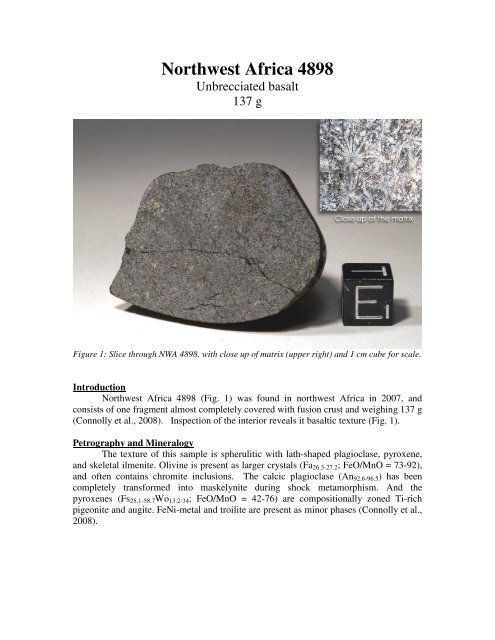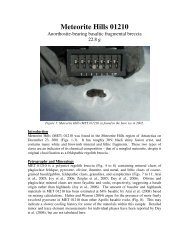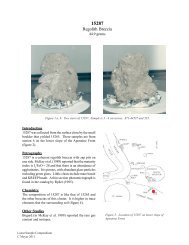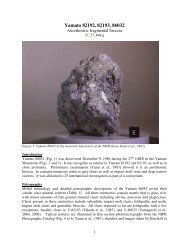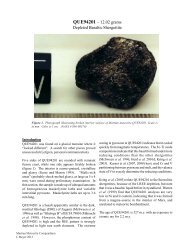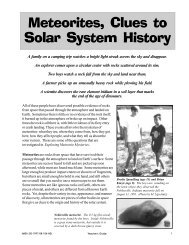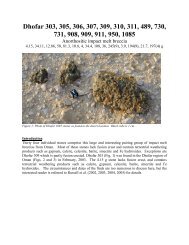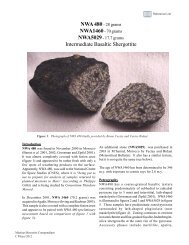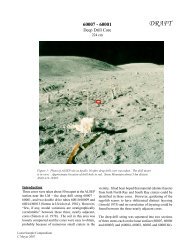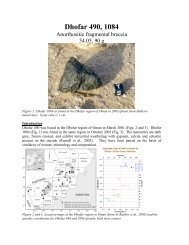B9 Northwest Africa 4898
B9 Northwest Africa 4898
B9 Northwest Africa 4898
Create successful ePaper yourself
Turn your PDF publications into a flip-book with our unique Google optimized e-Paper software.
<strong>Northwest</strong> <strong>Africa</strong> <strong>4898</strong><br />
Unbrecciated basalt<br />
137 g<br />
Figure 1: Slice through NWA <strong>4898</strong>, with close up of matrix (upper right) and 1 cm cube for scale.<br />
Introduction<br />
<strong>Northwest</strong> <strong>Africa</strong> <strong>4898</strong> (Fig. 1) was found in northwest <strong>Africa</strong> in 2007, and<br />
consists of one fragment almost completely covered with fusion crust and weighing 137 g<br />
(Connolly et al., 2008). Inspection of the interior reveals it basaltic texture (Fig. 1).<br />
Petrography and Mineralogy<br />
The texture of this sample is spherulitic with lath-shaped plagioclase, pyroxene,<br />
and skeletal ilmenite. Olivine is present as larger crystals (Fa 26.3-27.2 ; FeO/MnO = 73-92),<br />
and often contains chromite inclusions. The calcic plagioclase (An 92.6-96.5 ) has been<br />
completely transformed into maskelynite during shock metamorphism. And the<br />
pyroxenes (Fs 25.1-58.7 Wo 13.2-34 ; FeO/MnO = 42-76) are compositionally zoned Ti-rich<br />
pigeonite and augite. FeNi-metal and troilite are present as minor phases (Connolly et al.,<br />
2008).
Figure 2: Rare earth element diagram for<br />
NWA <strong>4898</strong> illustrating a Eu anomaly (from<br />
Korotev et al., 2008).<br />
Chemistry and Radiogenic age dating<br />
INAA analyses of 6 small (133<br />
mg total) chips of NWA <strong>4898</strong> reveal its<br />
low FeO nature (Table 1) and Eu<br />
anomaly (Fig. 2). A whole rock Rb-Sr<br />
isochron based on three measurements<br />
from NWA <strong>4898</strong> yields an age of 3.58<br />
Ga (Fig. 3; Gaffney et al., 2008).<br />
Additional Nd isotopic analyses show<br />
that NWA <strong>4898</strong> may have been derived<br />
from one of the most LREE depleted<br />
lunar mantle sources known (Fig. 4;<br />
Gaffney et al., 2008).<br />
Cosmogenic isotopes and exposure<br />
ages<br />
None yet reported.<br />
Figure 3: Whole rock isochron for<br />
NWA<strong>4898</strong> indicating an age of 3.58 Ga<br />
(from Gaffney et al., 2008).<br />
Figure 4: Results of Nd isotopic analyses of<br />
Gaffney et al (2008) showing the depleted<br />
nature of this sample relative to other<br />
Apollo, Luna and meteorite samples.
Table 1. Chemical composition of NWA <strong>4898</strong><br />
reference 1<br />
weight 133<br />
technique INAA<br />
SiO 2 % -<br />
TiO 2 -<br />
Al 2O 3 -<br />
Cr 2O 3 -<br />
FeO 17.2<br />
MnO -<br />
MgO -<br />
CaO -<br />
Na 2O 0.296<br />
K 2O -<br />
P 2O 5 -<br />
S % -<br />
sum -<br />
Sc ppm 65.4<br />
V<br />
Cr 3020<br />
Co<br />
Ni


